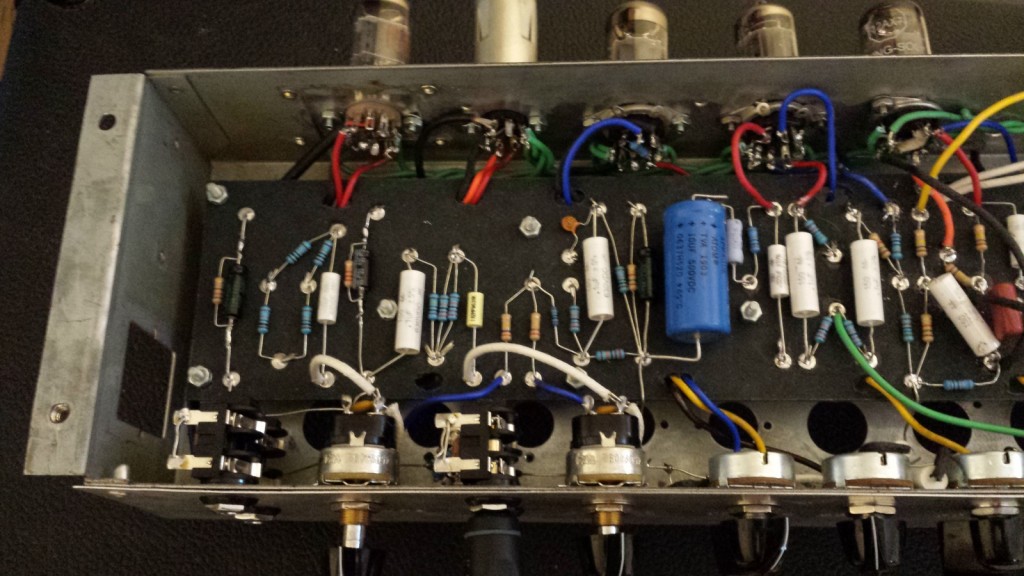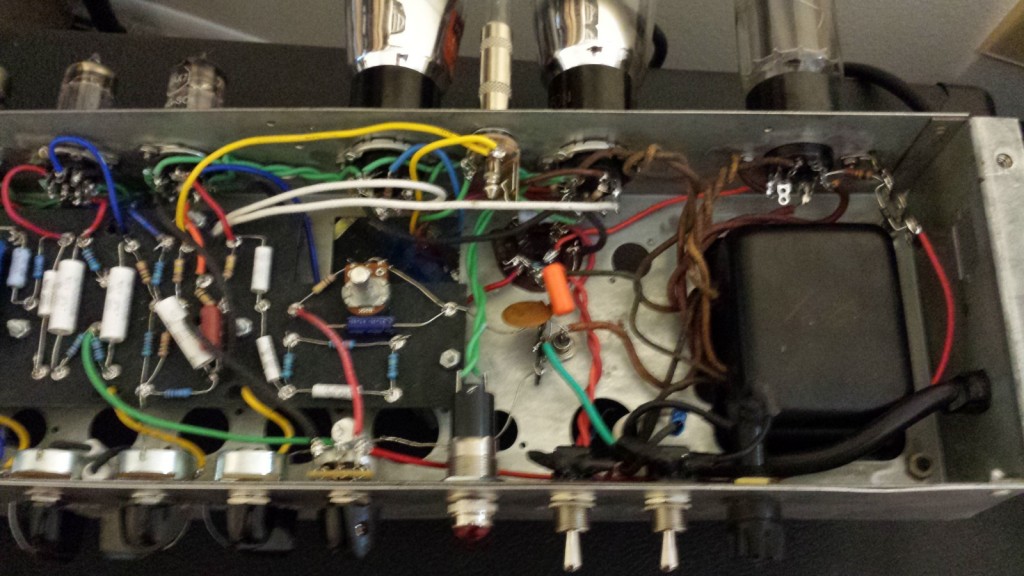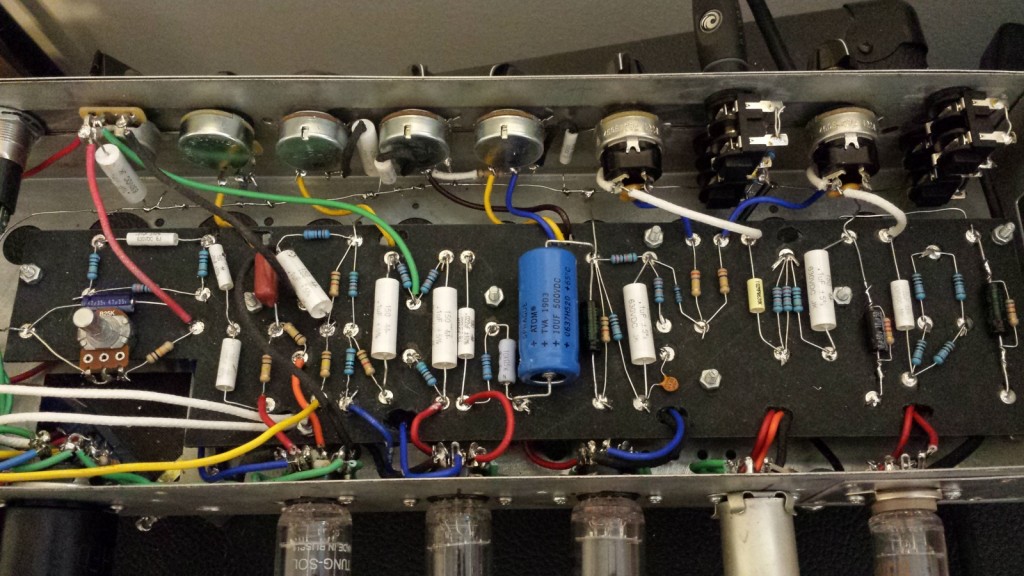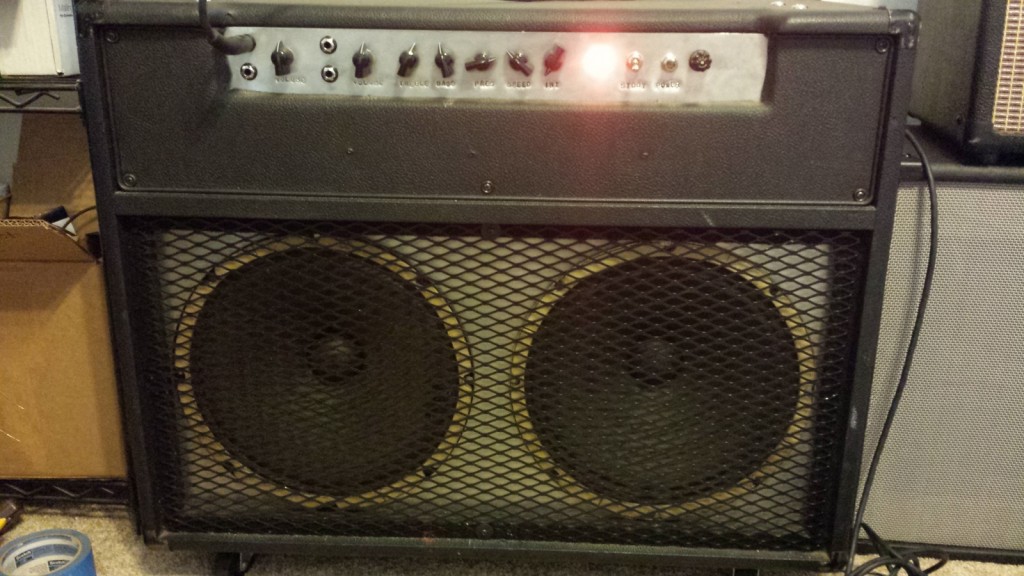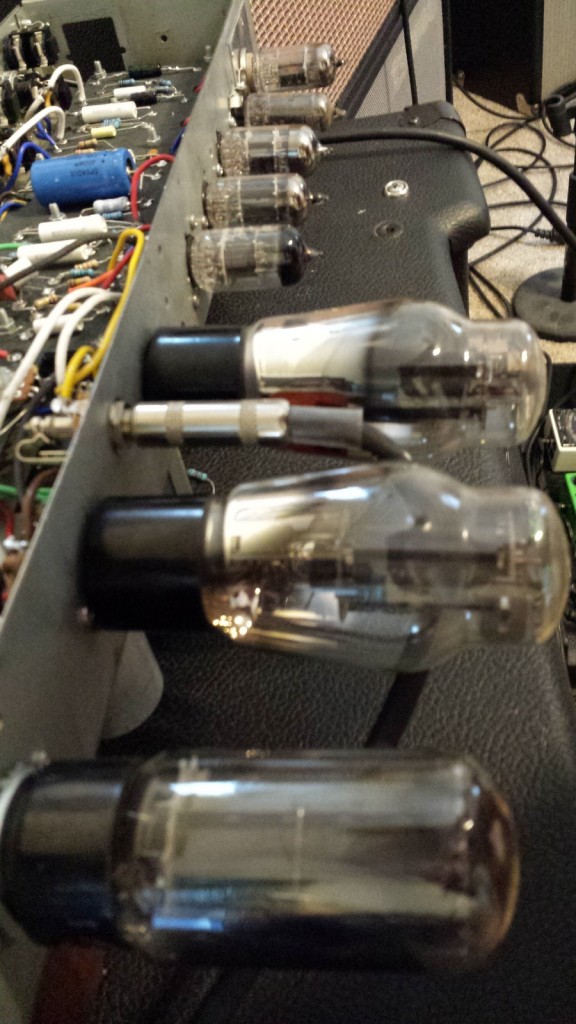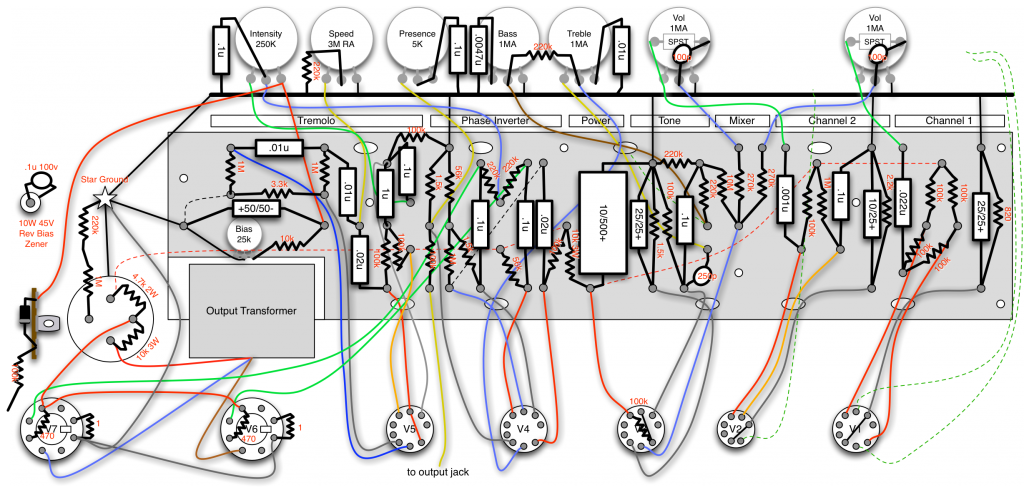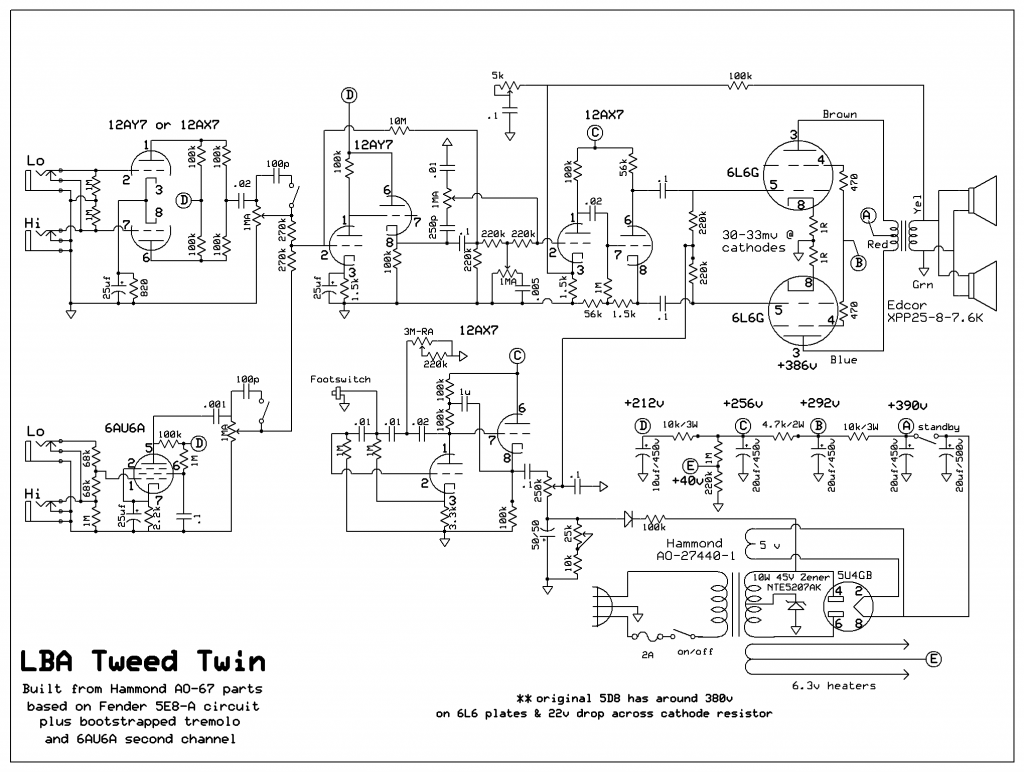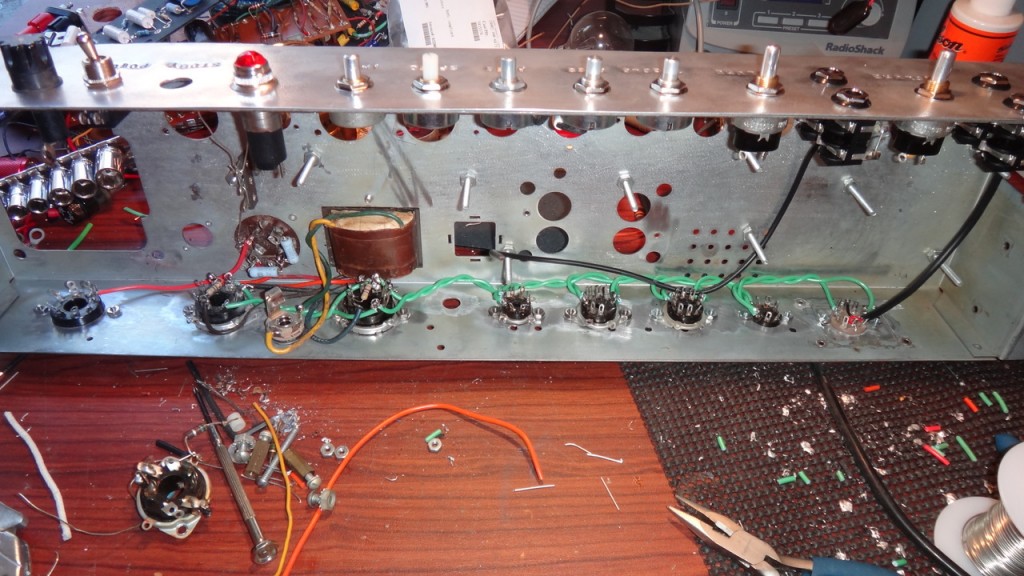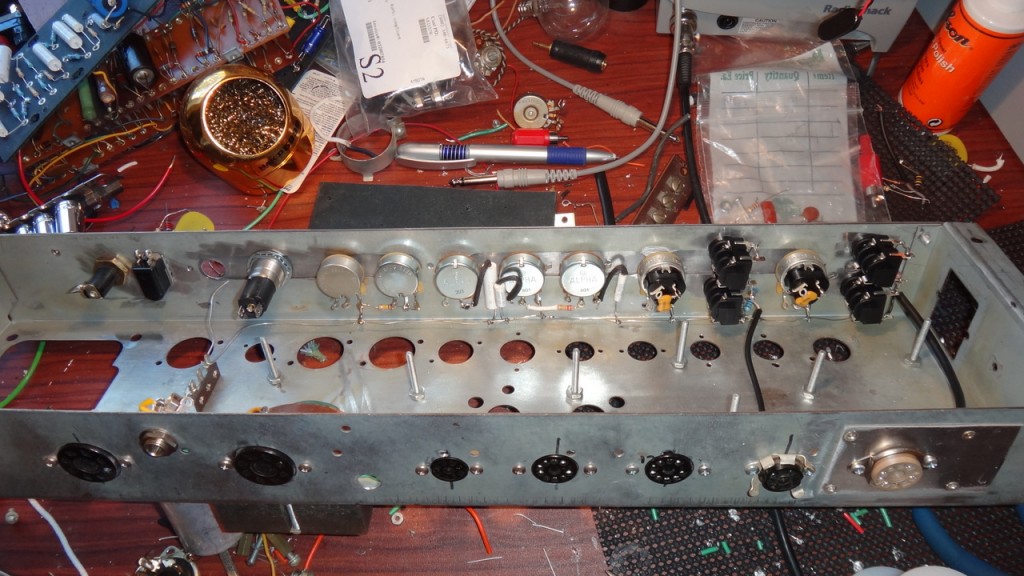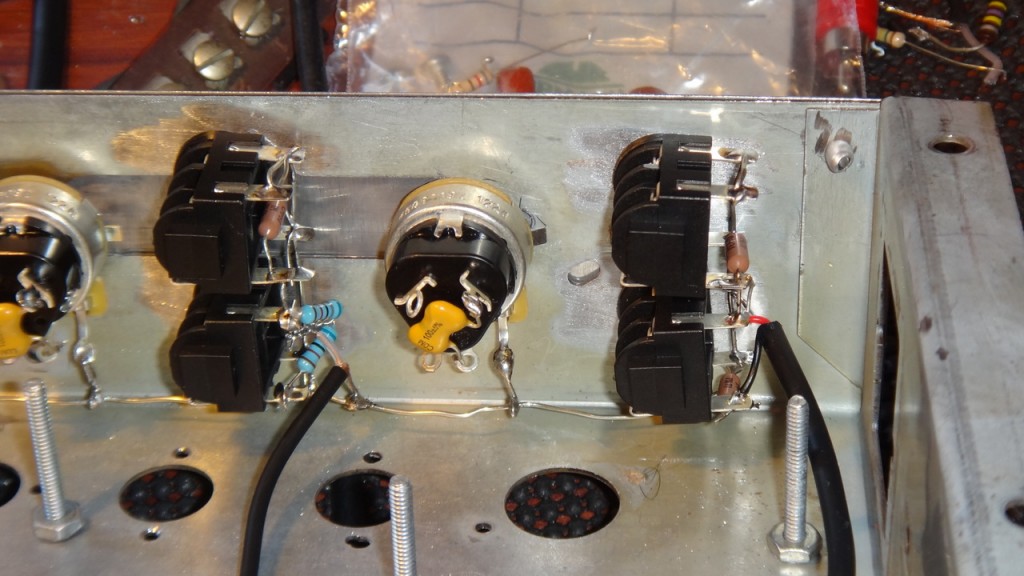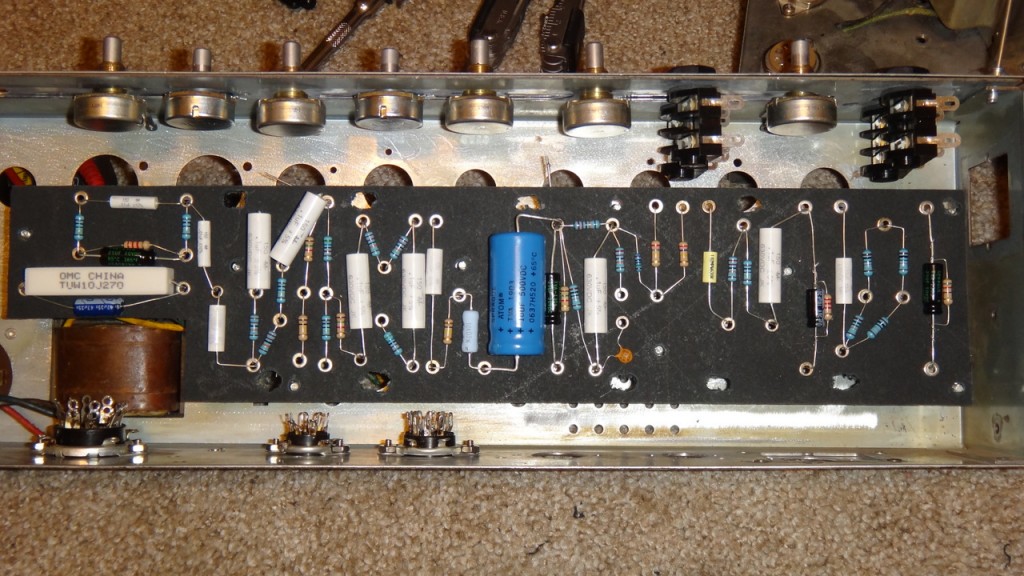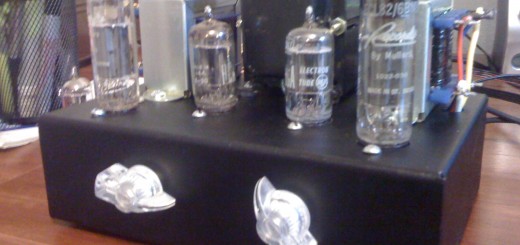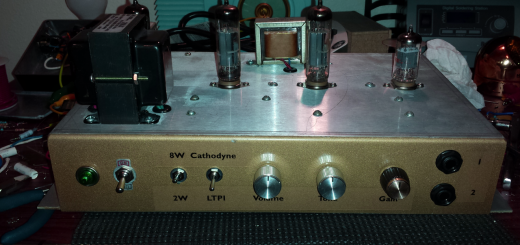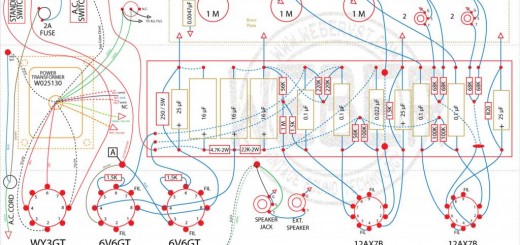When Frankie disassembled a Hammond M103 organ he picked up from the side of the road, I ended up with a huge pile of parts. Lucky me, an AO-67 amplifier and two Rola 12″ alnico speakers fell in my lap! By the look of the completely dry-rotted, twisted and shorted out 2-wire power cord and the incredible depth of dust on this thing I could tell it had been sitting for a bare minimum of 15 years. One of the speakers needed a little cone repair and all of the electrolytics were dried out.
With the idea of reusing as many components as possible, I took a hard look at the reusable bits and parts in my stash and figured out what I could build… A tweed or brown Fender Deluxe was the most obvious, but I already have a souped-up Brown Princeton. This one should be a little bigger… A low-power Tweed Twin made the most sense. The finished product is ultimately a 5E8-A Twin running at 5D8/5E8 voltages with added tremolo and a 6AU6 pentode second channel. Or, by subbing in 6V6 family power tubes, it’s pretty much a 5E4-A Super.
Power and Output
A pair of Raytheon 6L6G tubes, a power transformer with plenty of current output, a 5U4GB rectifier and two very old 15-watt alnico speakers… a perfect recipe for a 25w cathode-biased 6L6 circuit like the “big” 5C and 5D era Fender tweed amps! It turns out that this power transformer puts out a higher B+ than I expected, landing at around 425v at the plates and 27v at the cathode – a little too hot for my tastes. I installed a reverse-biased 45v zener diode under the HT center tap, which reduced the plate voltage to about 380v and 23v on the cathode – right in line with textbook 5D8 Twin operation.
Originally I decided against using the 5E-era fixed bias. I wanted a little less efficiency, a little more compression, and hopefully a little less strain on those old and brittle Rola speakers. Even so, one of the speakers tore its surround before I finished the amp. After lots of tinkering around with 5D8 phase inverters, output sections, and many different tremolo designs, I switched to using the 5E8-A circuit at 5D8/5E8 voltages.
The AO-24924 output transformer pulled from the Hammond was definitely on the small side and was holding back the power section. My first thought was to replace it with an Edcor CXPP25, but that model is too big to fit in the cabinet. The Allen Amps TO26 was another good option, but Edcor’s XPP25-8-7.6K has a larger core and was half the price! It has made a noticeable difference.
Phase Inverter
Since the rest of the tubes and sockets from the donor amp were 7-pin and 9-pin variants, I knew I wouldn’t be going with a 5B or 5C era circuit – those used octal tubes like the 6SC7 and 6J5. I started with the 5E-era AC-coupled 12AX7 cathodyne as used in the Twin, Bandmaster, Super and others. It’s a simple, reliable, and extremely proven circuit, especially with 6L6 output sections. No surprise, it sounded good. Then I tried the 5D8′s paraphase PI for a while, but it gave me too much grief with the tremolo so I went back to the 5E-era cathodyne.
Intermediate Stage and Tone Control
Looking over all of the variations in early tone controls and listening to how the circuits behaved, I decided to go with the 2-knob tone stack used in the 5E7 Bandmaster, 5F4 Super and 5E8-A Twin. It’s quite an improvement over the tone stack designs used in the 5D8 and 5E8 Twins and (again) has proven itself to be a very durable design.
There is one key discrepancy between the implementations of this intermediate stage: The Bandmaster and Super used a 12AX7, while the Twins used a 12AY7. The Super also used a smaller feedback resistor to increase the negative feedback of the stage (compensating somewhat for the higher gain of the 12AX7). I prefer the 12AY7 due to the lower input sensitivity and higher potential output swing. After all, if I want gain I can use my second preamp channel…
Input Sections
Since everything so far has come from a 5D8 or 5E8-A Twin, I knew the first channel would be based on a Twin design as well. I took the 5D8/5E8/5E8-A input stage and inserted a bright switch. That negated the need for the original second channel, so I set out to see what I could creatively reuse from the original Hammond parts.
Among the many bits and pieces I had a pair of 6AU6A preamp pentodes. I put in a pretty standard pentode circuit, similar those used with EF86 tubes. There’s a bright switch added but it’s completely unnecessary – the channel is already plenty bright. It has a lot of gain and easily overpowers the first channel. To help it keep up I use an RCA 12AX7 in V1 to keep the channels fairly close together in volume & drive. The second channel’s volume knob-to-overdrive relationship is pretty similar to most Blackface amps.
Let Nothing Go To Waste…
I had another 6AU6 sitting around. I love a good bias-vary tremolo, and a high-gain pentode makes a great one-tube oscillator. I just drew out a basic high-gain design and dropped in the classic 3-stage feedback loop using .02uf caps. With the cathodyne PI the tremolo was injected into the power tube input grids at their ground reference. It worked okay, but it was constantly fighting against the cathode biasing, reducing its effectiveness and creating an audible thumping.
When I switched to the Paraphase PI I had to take a different approach. The grid injection point is also the input to the second PI triode, so dumping the trem signal there messes up the PI before the power tubes even responded. That left me with a couple of choices. I tried adding a small capacitor to pin 7 of the PI to keep the trem signal out… no real luck. Injecting the tremolo at the power tube cathodes doesn’t work at all due to the high load against the high impedance pentode. Injecting the tremolo at a preamp cathode isn’t really effective for the same reason. Eventually I stumbled across the 5E9-A Tremolux circuit, which performs bias-vary tremolo against a paraphase PI. To pull it off requires a twin triode, so I drilled out the chassis hole a little bigger and put in a 9-pin socket. I settled on a bootstrapped cathode follower topology to maximize the tremolo intensity. The funky voltage divider network I had to use with the paraphase PI just wouldn’t provide decent results.
When I switched the PI back to a cathodyne I put the tremolo signal back on the power tube grids. The bootstrap oscillator provides more voltage swing than any bias-vary designs Fender used while still providing good current, making it a great match for a fixed-bias pair of 6L6Gs.
Cabinet and Chassis
Thanks to the power of Craigslist I got my hands on a 2×12 combo cabinet that originally housed a Roland Warhead amp. The front control panel opening is 19.25″ wide, giving me plenty of room to fit all of the inputs, knobs and switches. Unfortunately the amp compartment is only 6″ high, which means that I can’t mount big coke-bottle 6L6Gs (and probably not the 5U4GB) vertically. So what I’m doing is mounting them horizontally, opposite from the controls. This is how most tweed chassis are designed, but they’re usually mounted vertically in the back of the cabinet. I’m considering cutting out part of the cabinet top and installing a mesh grill to allow the power tube and rectifier heat to escape, but so far it hasn’t proved necessary.
Since the “face” side of the chassis already had huge, largely unusable holes, I cut a fresh sheet of .025″ aluminum and laid it over the face, riveting it into place where the original chassis rivets were. The control lettering is done extremely low-tech – 1/8″ lettering punches, hammered by hand. The face was then wire brushed to remove scratches and grain, then the rough surface was polished. The end effect is a front panel that looks like an industrial piece that has survived 50 years of wear and tear. It goes along well with the metal backpanel and grille that cover the speakers. Very cool if I do say so myself.

